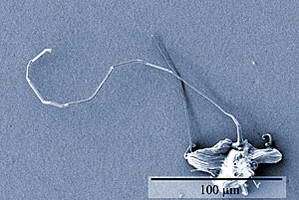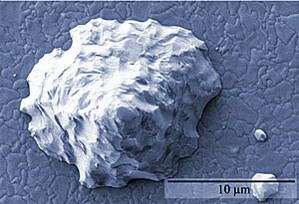Researchers Seeking Cure for Electronics-Killing Whiskers

Environmental groups around the world have been campaigning for years to replace lead-containing solders and protective layers on electronic components with non-hazardous metals and alloys. In response, the European Union (EU) will ban the use of lead (and five other hazardous substances) in all electrical and electronic equipment sold in EU nations starting in July 2006. U.S. manufacturers must comply with this requirement in order to market their products overseas.
Image: Colorized scanning electron micrograph (SEM) shows a "whisker" on the surface of a tin-copper alloy. The image was taken 176 days after the alloy was electroplated onto a tiny cantilever beam.
However, pure electroplated tin and lead-free tin alloys tend to spontaneously grow metallic whiskers (thin filament-like structures often several millimeters long) during service. These defects can lead to electrical shorts and failures across component leads and connectors.

Micrograph of a "hillock" on an electrodeposited surface of pure tin (10 times the magnification of top image). Image credit:NIST/Boettinger et al., Acta Materialia,5033-5050
Whiskers—and more benign raised formations called hillocks—are believed to be a metal’s means of relieving stress generated by the electroplating process, so National Institute of Standards and Technology (NIST) researchers—working with the International Electronics Manufacturing Initiative (iNEMI)—have been trying to identify the origins of such stresses and better understand the resulting mechanisms for whisker and hillock growth. In a recent paper in Acta Materialia,* they reported that the surfaces of tin-copper deposits developed extremely long whiskers while pure tin deposits (the simplest lead-free plating finish) only produced hillocks. By comparison, the soon-to-be-banned tin-lead deposits did not form either type of deformity (a characteristic known since the 1960s).
The NIST researchers determined that whiskers and hillocks form when the boundaries between individual grains in a deposit have a column-shaped structure. If the boundaries move laterally, hillocks form. When copper impurities hold the columnar boundaries immobile, whiskers are the result. A tin-lead deposit possesses randomly structured boundaries that do not create either of these actions.
Based on these findings, the NIST researchers are exploring ways of eliminating the stresses and creating deposit structures without column grains that elicit whiskers and hillocks. One possibility involves using an alternating current on/current off electroplating process instead of the traditional continuous current method. This could disrupt the formation of columnar boundaries, yielding a structure similar to that of a tin-lead deposit but without lead’s environmental danger.
* Boettinger W.J., Johnson C.E., Bendersky L.A., Moon K-W, Williams M.E. and Stafford G.R. Whisker and hillock formation on Sn, Sn-Cu and Sn-Pb electrodeposits. Acta Materialia Vol. 53, Issue 19, pp. 5033-5050 (November 2005)
Source: NIST


















